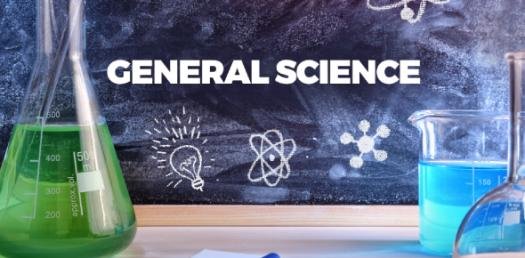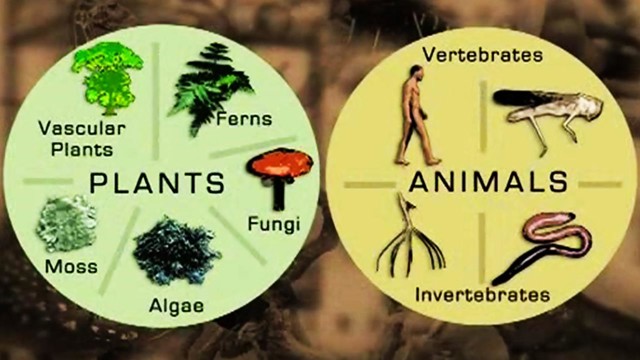Biological Classification of Plants and Animals
- Biological classification of plants and animals was first proposed by Aristotle on the basis of simple morphological characters.
- Linnaeus later classified all living organisms into two kingdoms – Plantae and Animalia.
- Whittaker proposed an elaborate five kingdom classification – Monera, Protista, Fungi, Plantae and Animalia.
- The main criteria of the five kingdom classification were cell structure, body organisation, mode of nutrition and reproduction, and phylogenetic relationships [evolutionary development and diversification of a species].
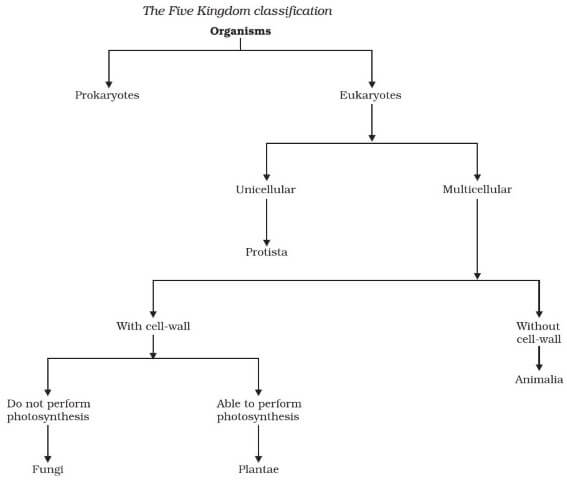
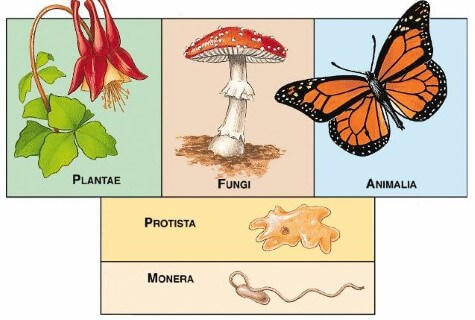
At present, the biological classification includes:
- Kingdom Monera
- Kingdom Protista
- Kingdom Fungi
- Kingdom Plantae
- Kingdom Animalia
- Viruses, Viroids and Lichens
- In the five kingdom classification, bacteria are included in Kingdom Monera.
- Kingdom Protista includes all single-celled eukaryotes such as Chrysophytes, Dinoflagellates, Euglenoids, Slime-moulds and Protozoans.
- Members of Kingdom Fungi show a great diversity in structures and habitat. Most fungi are saprophytic in their mode of nutrition.
- The plantae includes all eukaryotic chlorophyll-containing organisms. Algae, bryophytes, pteridophytes, gymnosperms and angiosperms are included in this group.
- The heterotrophic eukaryotic, multicellular organisms lacking a cell wall are included in the Kingdom Animalia.
- Some acellular organisms like viruses and viroids as well as the lichens are not included in the five kingdom system of classification.
Kingdom Monera
- The organisms in this group are
- prokaryotes == do not have a defined nucleus or organelles {Prokaryotic Cells vs. Eukaryotic Cells}.
- unicellular == do any of them show multi-cellular body designs.
- This group includes all Some well-known bacteria include blue-green algae or cyanobacteria [have cell walls], and mycoplasma [doesn’t possess a Cell Wall].
- They are the most abundant micro-organisms and live in extreme habitats.
- Some of them have cell walls [bacteria] while some do not [mycoplasma].
- The mode of nutrition of organisms in this group can be either by synthesizing their own food (autotrophic) or getting it from the environment (heterotrophic). Many of them live in or on other organisms as parasites.
- Bacteria are grouped under four categories based on their shape
- the spherical Coccus
- the rod-shaped Bacillus
- the comma-shaped Vibrium
- the spiral Spirillum

- Some of the bacteria are autotrophic, i.e., they synthesise their own food. They may be photosynthetic autotrophic or chemosynthetic autotrophic (metabolic synthesis of organic compounds by living organisms using energy derived from reactions involving inorganic chemicals).
Archaebacteria
- These bacteria are special since they live in some of the most harsh habitats such as
- extreme salty areas (halophiles),
- hot springs (thermoacidophiles) and
- marshy areas (methanogens) {Microbes In Human Welfare | Useful Microbes}.
- Archaebacteria differ from other bacteria in having a different cell wall structure and this feature is responsible for their survival in extreme conditions.
- Methanogens are present in the gut of several ruminant animals such as cows and buffaloes and they are responsible for the production of methane (biogas) from the dung of these animals.
Eubacteria
- There are thousands of different eubacteria or ‘true bacteria’.
- They are characterized by the presence of a rigid cell wall, and if motile, a flagellum.
Photosynthetic bacteria
- The cyanobacteria (also referred to as blue-green algae) have chlorophyll a similar to green plants and are photosynthetic autotrophs.
- The cyanobacteria are unicellular, colonial, filamentous, freshwater/marine or terrestrial algae. The colonies are generally surrounded by gelatinous sheath.
- They often form blooms [algal blooms] in polluted water bodies.
- Some of these organisms can fix atmospheric nitrogen in specialized cells called heterocysts, e.g., Nostoc and Anabaena.
Chemosynthetic bacteria
- Chemosynthetic autotrophic bacteria oxidise various inorganic substances such as nitrates, nitrites and ammonia and use the released energy for their ATP production.
- They play a great role in recycling nutrients like nitrogen, phosphorous, iron and sulphur.
Heterotrophic bacteria
- Heterotrophic bacteria are the most abundant in nature. The majority are important decomposers.
- Many of them have a significant impact on human affairs. They are helpful in making curd from milk, production of antibiotics, fixing nitrogen in legume roots, etc {Microbes In Human Welfare | Useful Microbes}.
- Some are pathogens causing damage to human beings, crops, farm animals and pets.
- Cholera, typhoid, tetanus, citrus canker are well known diseases caused by different bacteria {Diseases Caused by Microorganisms, Diseases | Acute, Chronic, Communicable Diseases}.
Reproduction
- Bacteria reproduce mainly by fission.
- Sometimes, under unfavorable conditions, they produce spores.
- They also reproduce by a sort of sexual reproduction by adopting a primitive type of DNA transfer from one bacterium to the other.
Mycoplasma
- The Mycoplasma are organisms that completely lack a cell wall.
- They are the smallest living cells known and can survive without oxygen.
- Many mycoplasma are pathogenic in animals and plants.
Kingdom Protista
- All single-celled eukaryotes are placed under Protista [Prokaryotic Cells vs. Eukaryotic Cells].
- Boundaries of this kingdom are not well defined. This kingdom forms a link with the others dealing with plants, animals and fungi.
- In this group we include Chrysophytes, Dinoflagellates, Euglenoids, Slime moulds and Protozoans. Examples are unicellular algae, diatoms and protozoans.
- Their mode of nutrition can be autotrophic or heterotrophic.
- Members of Protista are primarily aquatic. Some have flagella or cilia that helps in movement.
- Protists reproduce asexually and sexually by a process involving cell fusion and zygote formation.
Chrysophytes
- This group includes diatoms and golden algae (desmids).
- Most of them are photosynthetic. Diatoms are the chief ‘producers’ in the oceans.
- They are found in fresh water as well as in marine environments. They are microscopic and float passively in water currents (plankton).
- In diatoms the cell walls form two thin overlapping shells. The walls are embedded with silica and thus the walls are indestructible. Thus, diatoms have left behind large amount of cell wall deposits in their habitat; this accumulation over billions of years is referred to as ‘diatomaceous earth’. Being gritty this soil is used in polishing, filtration of oils and syrups.
Dinoflagellates
- These organisms are mostly marine and photosynthetic.
- They appear yellow, green, brown, blue or red depending on the main pigments present in their cells.
- The cell wall has stiff cellulose plates on the outer surface.
- Most of them have two flagella; one lies longitudinally and the other transversely in a furrow between the wall plates.
- Very often, red dinoflagellates (Example: Gonyaulax) undergo such rapid multiplication that they make the sea appear red (red tides).
- Toxins released by such large numbers may even kill other marine animals such as fishes.
Euglenoids
- Majority of them are fresh water organisms found in stagnant water.
- Instead of a cell wall, they have a protein rich layer called pellicle which makes their body flexible.
- They have two flagella, a short and a long one.
- Though they are photosynthetic in the presence of sunlight, when deprived of sunlight they behave like heterotrophs by predating on other smaller organisms.
- Interestingly, the pigments of euglenoids are identical to those present in higher plants. Example: Euglena.
Slime Moulds
- Slime moulds are saprophytic protists.
- The body moves along decaying twigs and leaves engulfing organic material.
- Under suitable conditions, they form an aggregation called plasmodium which may grow and spread over several feet.
- During unfavorable conditions, the plasmodium differentiates and forms fruiting bodies bearing spores at their tips. The spores possess true walls. They are extremely resistant and survive for many years, even under adverse conditions. The spores are dispersed by air currents.
Protozoans
- All protozoans are heterotrophs and live as predators or parasites. They are believed to be primitive relatives of animals. There are four major groups of protozoans.
Amoeboid protozoans
- These organisms live in fresh water, sea water or moist soil.
- They move and capture their prey by putting out pseudopodia (false feet) as in Amoeba.
- Marine forms have silica shells on their surface. Some of them such as Entamoeba are parasites.
Flagellated protozoans
- The members of this group are either free-living or parasitic. They have flagella.
- The parasitic forms cause diseases such as sleeping sickness. Example: Trypanosoma.
Ciliated protozoans
- These are aquatic, actively moving organisms because of the presence of thousands of cilia.
- They have a cavity (gullet) that opens to the outside of the cell surface. The coordinated movement of rows of cilia causes the water laden with food to be steered into the gullet. Example: Paramoecium.
Sporozoans
- This includes diverse organisms that have an infectious spore-like stage in their life cycle.
- The most notorious is Plasmodium (malarial parasite) which causes malaria, a disease which has a staggering effect on human population {Diseases Caused by Microorganisms}.
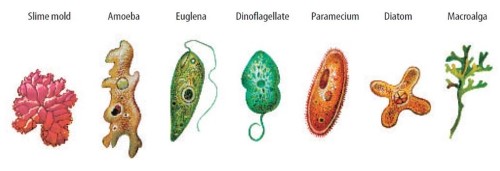
Kingdom Fungi
- These are heterotrophic eukaryotic organisms.
- Most fungi are heterotrophic and absorb soluble organic matter from dead substrates and hence are called saprophytes.
- Those that depend on living plants and animals are called parasites.
- Some fungal species live in permanent mutually dependent relationships with bluegreen algae (or cyanobacteria). Such relationships are called symbiotic. These symbiobic life forms are called lichens. They can also live as symbionts in association with roots of higher plants as mycorrhiza.
- Fungi + Bluegreen algae (Cyanobacteria) == Lichens. (Prelims 2014)
- Reproduction in fungi can take place by vegetative means – fragmentation, fission and budding.
- Asexual reproduction is by spores called conidia or sporangiospores or zoospores, and sexual reproduction is by oospores, ascospores and basidiospores.
- The various spores are produced in distinct structures called fruiting bodies. The sexual cycle involves the following three steps:
- Fusion of protoplasms between two motile or non-motile gametes called plasmogamy.
- Fusion of two nuclei called karyogamy.
- Meiosis in zygote resulting in haploid spores {Meiosis | Mitosis – Meiosis Comparison}.
- When a fungus reproduces sexually, two haploid hyphae of compatible mating types come together and fuse. In some fungi the fusion of two haploid cells immediately results in diploid cells (2n).
- However, in other fungi (ascomycetes and basidiomycetes), an intervening dikaryotic stage (n + n, i.e., two nuclei per cell) occurs; such a condition is called a dikaryon and the phase is called dikaryophase of fungus. Later, the parental nuclei fuse and the cells become diploid. The fungi form fruiting bodies in which reduction division occurs, leading to formation of haploid spores.
- Many of fungi have the capacity to become multicellular organisms at certain stages in their lives.
- They have cell-walls made of a tough complex sugar called chitin.
- Fungi are cosmopolitan and occur in air, water, soil and on animals and plants.
- They prefer to grow in warm and humid places. With the exception of yeasts which are unicellular, fungi are filamentous.
- Their bodies consist of long, slender thread-like structures called hyphae. The network of hyphae is known as mycelium.
- Some hyphae are continuous tubes filled with multinucleated cytoplasm – these are called coenocytic hyphae.
- Others have septae or cross walls in their hyphae. The cell walls of fungi are composed of chitin and polysaccharides {Carbohydrates | Monosaccharides | Polysaccharides}.
- When your bread develops a mould or your orange rots it is because of fungi.
- The common mushroom you eat and toadstools are also fungi.
- White spots seen on mustard leaves are due to a parasitic fungus.
- Some unicellular fungi, e.g., yeast are used to make bread and beer.
- Other fungi cause diseases in plants and animals; wheat rust-causing Puccinia is an important example.
- Some are the source of antibiotics, e.g., Penicillium.
Phycomycetes
- Asexual reproduction takes place by zoospores (motile) or by aplanospores (non-motile).
- These spores are endogenously produced in sporangium.
- A zygospore is formed by fusion of two gametes.
- These gametes are similar in morphology (isogamous) or dissimilar (anisogamous or oogamous).
- Some common examples are Mucor, Rhizopus (the bread mould mentioned earlier) and Albugo (the parasitic fungi on mustard).
Ascomycetes
- Commonly known as sac-fungi, the as comycetes are mostly multicellular, e.g., Penicillium, or rarely unicellular, e.g., yeast (Saccharomyces).
Basidiomycetes
- Commonly known forms of basidiomycetes are mushrooms, bracket fungi or puffballs.
- They grow in soil, on logs and tree stumps and in living plant bodies as parasites, e.g., rusts and smuts.
- The asexual spores are generally not found, but vegetative reproduction by fragmentation is common.
- The sex organs are absent, but plasmogamy is brought about by fusion of two vegetative or somatic cells of different strains or genotypes. The resultant structure is dikaryotic.
Deuteromycetes
- Commonly known as imperfect fungi because only the asexual or vegetative phases of these fungi are known.
Kingdom Plantae
- These are multicellular eukaryotes with cell walls mainly made of cellulose {Plant Cell vs. Animal Cell}.
- They are autotrophs and use chlorophyll for photosynthesis.
- A few members are partially heterotrophic such as the insectivorous plants or parasites. Bladderwort and Venus fly trap are examples of insectivorous plants and Cuscuta is a parasite.
- Plantae includes algae, bryophytes, pteridophytes, gymnosperms and angiosperms.
- Life cycle of plants has two distinct phases – the diploid sporophytic and the haploid gametophytic – that alternate with each other.
- The lengths of the haploid and diploid phases, and whether these phases are free-living or dependent on others, vary among different groups in plants. This phenomenon is called alternation of generation.
Kingdom Animalia
- These include all organisms which are multicellular eukaryotes without cell walls. They are heterotrophs.
- They directly or indirectly depend on plants for food. They digest their food in an internal cavity and store food reserves as glycogen or fat { Carbohydrates , Fats – Healthy Fats and Unhealthy Fats}.
- Their mode of nutrition is holozoic – by ingestion of food.
- They follow a definite growth pattern and grow into adults that have a definite shape and size.
- Higher forms show elaborate sensory and neuromotor mechanism. Most of them are capable of locomotion.
- The sexual reproduction is by copulation of male and female followed by embryological development.
Viruses, Viroids and Lichens
- In the five kingdom classification of Whittaker {Biological Classification} there is no mention of some acellular organisms like viruses and viroids, and lichens. These are briefly introduced here.
- Viruses did not find a place in classification since they are not truly ‘living’, if we understand living as those organisms that have a cell structure.
- The viruses are non-cellular organisms that are characterized by having an inert crystalline structure outside the living cell.
- Viruses are obligate parasites. Once they infect a cell they take over the machinery of the host cell to replicate themselves, killing the host.
- The name virus that means venom or poisonous fluid was given by Pasteur.
- In addition to proteins, viruses also contain genetic material, that could be either RNA or DNA. No virus contains both RNA and DNA.
- In general, viruses that infect plants have single stranded RNA and viruses that infect animals have either single or double stranded RNA or double stranded DNA.
- Bacterial viruses or bacteriophages (viruses that infect the bacteria) are usually double stranded DNA viruses
- The protein coat called capsid made of small subunits called capsomeres, protects the nucleic acid. These capsomeres are arranged in helical or polyhedral geometric forms.
- Viruses cause diseases like mumps, small pox, herpes and influenza. AIDS in humans is also caused by a virus.
- In plants, the symptoms can be mosaic formation, leaf rolling and curling, yellowing and vein clearing, dwarfing and stunted growth.
Viroids
- Viroids are infectious agents that are smaller than viruses. A viroid was found to be a free RNA; it lacked the protein coat that is found in viruses, hence the name viroid. The RNA of the viroid was of low molecular weight. Viroids caused potato spindle tuber disease.
Lichens
- Lichens are symbiotic associations i.e. mutually useful associations, between algae and fungi.
- The algal component is known as phycobiont and fungal component as mycobiont, which are autotrophic and heterotrophic, respectively.
- Algae prepare food for fungi and fungi provide shelter and absorb mineral nutrients and water for its partner.
- So close is their association that if one saw a lichen in nature one would never imagine that they had two different organisms within them.
- Lichens are very good pollution indicators – they do not grow in polluted areas.

